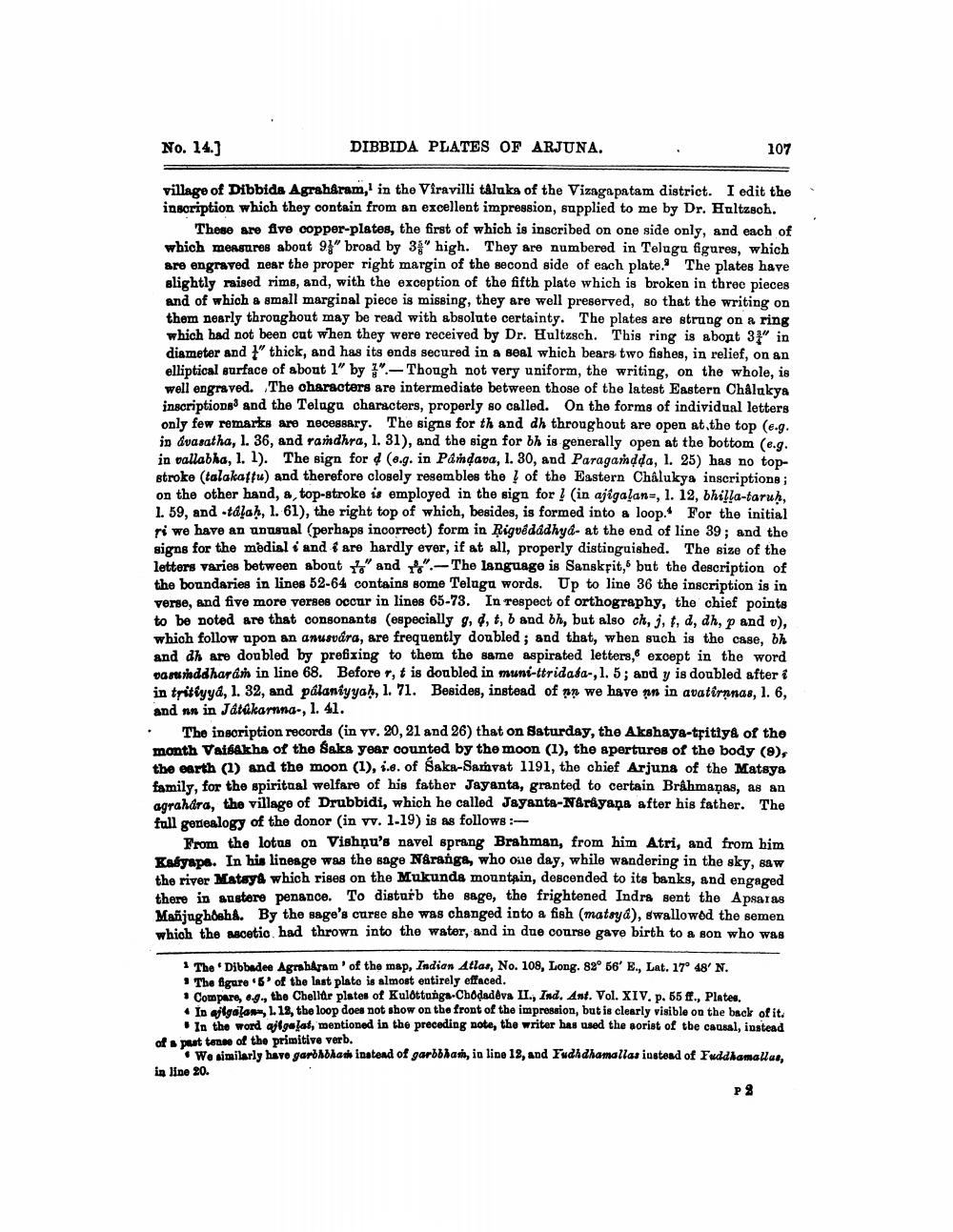________________
No. 14.]
village of Dibbida Agraharam, in the Viravilli taluks of the Vizagapatam district. I edit the inscription which they contain from an excellent impression, supplied to me by Dr. Hultzsch.
DIBBIDA PLATES OF ARJUNA.
107
These are five copper-plates, the first of which is inscribed on one side only, and each of which measures about 93" broad by 35" high. They are numbered in Telugu figures, which are engraved near the proper right margin of the second side of each plate. The plates have slightly raised rims, and, with the exception of the fifth plate which is broken in three pieces and of which a small marginal piece is missing, they are well preserved, so that the writing on them nearly throughout may be read with absolute certainty. The plates are strung on a ring which had not been cut when they were received by Dr. Hultzsch. This ring is about 31" in diameter and " thick, and has its ends secured in a seal which bears two fishes, in relief, on an elliptical surface of about 1" by ".-Though not very uniform, the writing, on the whole, is well engraved. The characters are intermediate between those of the latest Eastern Châlukya inscriptions3 and the Telugu characters, properly so called. On the forms of individual letters only few remarks are necessary. The signs for th and dh throughout are open at the top (e.g. in dvasatha, 1. 36, and ramdhra, 1. 31), and the sign for bh is generally open at the bottom (e.g. in vallabha, 1. 1). The sign for d (e.g. in Pandava, 1. 30, and Paragamḍda, 1. 25) has no topstroke (talakaṭṭu) and therefore closely resembles the of the Eastern Châlukya inscriptions; on the other hand, a, top-stroke is employed in the sign for (in ajigalan, 1. 12, bhilla-taruḥ, 1. 59, and -tálaḥ, 1. 61), the right top of which, besides, is formed into a loop. For the initial ri we have an unusual (perhaps incorrect) form in Rigvédádhyd- at the end of line 39; and the signs for the medial i and are hardly ever, if at all, properly distinguished. The size of the letters varies between about " and "-The language is Sanskrit, but the description of the boundaries in lines 52-64 contains some Telugu words. Up to line 36 the inscription is in verse, and five more verses occur in lines 65-73. In respect of orthography, the chief points to be noted are that consonants (especially g, 4, t, b and bh, but also ch, j, t, d, dh, p and v), which follow upon an anusvára, are frequently doubled; and that, when such is the case, bh and dh are doubled by prefixing to them the same aspirated letters, except in the word vasuṁddharam in line 68. Before r, t is doubled in muni-ttridasa-, 1. 5; and y is doubled after i in tritiyya, 1. 32, and palaniyyah, 1. 71. Besides, instead of an we have pn in avatîrnnas, 1. 6, and nn in Játékarnna-, 1. 41.
The inscription records (in vv. 20, 21 and 26) that on Saturday, the Akshaya-tritiya of the month Vaisakhs of the Saka year counted by the moon (1), the apertures of the body (9), the earth (1) and the moon (1), i.e. of Saka-Samvat 1191, the chief Arjuna of the Matsya family, for the spiritual welfare of his father Jayanta, granted to certain Brahmanas, as an agrahara, the village of Drubbidi, which he called Jayanta-Narayana after his father. The full genealogy of the donor (in vv. 1-19) is as follows:
From the lotus on Vishnu's navel sprang Brahman, from him Atri, and from him Kasyapa. In his lineage was the sage Naranga, who one day, while wandering in the sky, saw the river Matsya which rises on the Mukunda mountain, descended to its banks, and engaged there in austere penance. To disturb the sage, the frightened Indra sent the Apsaras Mañjughosha. By the sage's curse she was changed into a fish (matsya), swallowed the semen which the ascetic had thrown into the water, and in due course gave birth to a son who was
The 'Dibbadee Agraharam' of the map, Indian Atlas, No. 108, Long. 82° 56′ E., Lat. 17° 48' N. The figure '5' of the last plate is almost entirely effaced.
Compare, e.g., the Chellar plates of Kulottunga-Chodadeva II., Ind. Ant. Vol. XIV. p. 55 ff., Plates.
In ajigalas, 1. 18, the loop does not show on the front of the impression, but is clearly visible on the back of it. In the word ajigalat, mentioned in the preceding note, the writer has used the aorist of the causal, instead of a past tense of the primitive verb.
We similarly have garbhbham instead of garbbham, in line 12, and Fudhdhamallas instead of Fuddhamallus,
in line 20.
P2




